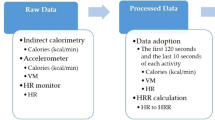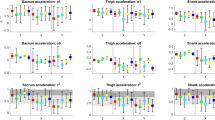Abstract
Objective:
This study aimed to assess the validity and reliability of the 3DNX triaxial accelerometer in a laboratory and mechanical setting.
Methods:
Experiment 1: A total of 10 units were fixed to a Multi-axis shaker table. A schedule comprising a range of accelerations was repeated on two occasions along each of the three measurement axes. Experiment 2: A total of 11 recreationally active individuals completed a treadmill protocol (4–20 km hr−1) on two occasions. Two 3DNX accelerometers were secured to the lower back, logging data every 5 s. Oxygen uptake was measured using the Douglas Bag technique. Reliability inter- and intra-units were assessed using a combination of limits of agreement (LoA), coefficient of variation (CV) and intra-class correlation coefficient (ICC). Validity was assessed using simple linear regression. All data are expressed in counts per 5 s (counts 5 s−1).
Results:
Experiment 1: CVintra ranged from 0.0 to 8.9% in all axes. The absolute bias±95% LoA values were all below four counts 5 s−1. CVinter did not rise above 4.5%. ICCs were 1.0 for all stages in all axes. The relationship between 3DNX counts and acceleration yielded an R2 value of 0.99 and a standard error of the estimate (SEE) of six counts 5 s−1. Experiment 2: CVinter ranged from 7.7 to 16.0% for trial 1 and from 7.7 to 16.2% for trial 2. ICCs between units ranged from 0.95 to 1.00 for trial 1 and from 0.90 to 0.99 for trial 2. Mean ratio bias±95% LoA values for intra-unit and inter-unit reliability were −0.7% (P>0.05)±12.4% and 0.4% (P>0.05)±5.6%, respectively. The relationship between V̇O2 and 3DNX counts for walking and running was linear (R2=0.65, SEE=1.42 ml kg−1 min−1; R2=0.62, SEE=3.63 ml kg−1 min−1).
Conclusion:
The 3DNX accelerometer is a reliable and valid device for measuring acceleration in a mechanical setting and during human treadmill exercise.
This is a preview of subscription content, access via your institution
Access options
Subscribe to this journal
Receive 12 print issues and online access
$259.00 per year
only $21.58 per issue
Buy this article
- Purchase on Springer Link
- Instant access to full article PDF
Prices may be subject to local taxes which are calculated during checkout





Similar content being viewed by others
References
Pate RR, Pratt M, Blair SN, Haskell WL, Macera CA, Bouchard C et al. Physical activity and public health. A recommendation from the Centers for Disease Control and Prevention and the American College of Sports Medicine. JAMA 1995; 273: 402–407.
Reilly JJ . Obesity in childhood and adolescence: evidence based clinical and public health perspectives. Postgrad Med J 2006; 82: 429–437.
Maddison R, Jiang Y, Hoorn SV, Mhurchu CN, Lawes CM, Rodgers A et al. Estimating energy expenditure with the RT3 triaxial accelerometer. Res Q Exerc Sport 2009; 80: 249–256.
Plasqui G, Westerterp KR . Physical activity assessment with accelerometers: an evaluation against doubly labeled water. Obesity (Silver Spring) 2007; 15: 2371–2379.
Pober DM, Staudenmayer J, Raphael C, Freedson PS . Development of novel techniques to classify physical activity mode using accelerometers. Med Sci Sports Exerc 2006; 38: 1626–1634.
Chen KY, Bassett Jr DR . The technology of accelerometry-based activity monitors: current and future. Med Sci Sports Exerc 2005; 37 (11 Suppl): S490–S500.
Chu EY, McManus AM, Yu CC . Calibration of the RT3 accelerometer for ambulation and nonambulation in children. Med Sci Sports Exerc 2007; 39 (11): 2085–2091.
McKenzie KL . 2009 C.H. McCloy Lecture. Seeing is believing: observing physical activity and its contexts. Res Q Exerc Sport 2010; 81: 113–122.
Esliger DW, Tremblay MS . Technical reliability assessment of three accelerometer models in a mechanical setup. Med Sci Sports Exerc 2006; 38: 2173–2181.
Welk GJ, Blair SN, Wood K, Jones S, Thompson RW . A comparative evaluation of three accelerometry-based physical activity monitors. Med Sci Sports Exerc 2000; 32 (9 Suppl): S489–S497.
Plasqui G, Joosen AM, Kester AD, Goris AH, Westerterp KR . Measuring free-living energy expenditure and physical activity with triaxial accelerometry. Obes Res 2005; 13: 1363–1369.
Hendelman D, Miller K, Baggett C, Debold E, Freedson P . Validity of accelerometry for the assessment of moderate intensity physical activity in the field. Med Sci Sports Exerc 2000; 32 (9 Suppl): S442–S449.
Trost SG, McIver KL, Pate RR . Conducting accelerometer-based activity assessments in field-based research. Med Sci Sports Exerc 2005; 37 (11 Suppl): S531–S543.
Campbell KL, Crocker PR, McKenzie DC . Field evaluation of energy expenditure in women using Tritrac accelerometers. Med Sci Sports Exerc 2002; 34: 1667–1674.
Fudge BW, Wilson J, Easton C, Irwin L, Clark J, Haddow O et al. Estimation of oxygen uptake during fast running using accelerometry and heart rate. Med Sci Sports Exerc 2007; 39: 192–198.
Richmond V, Wilkinson D, Carter J, Blacker S, Rayson M . Validity of the 3DNX™ accelerometer for predicting oxygen uptake. International Conference on Contemporary Ergonomics. Routledge: London, UK, 2007.
Carter J, Wilkinson D, Blacker S, Rayson M, Bilzon J, Izard R et al. An investigation of a novel three-dimensional activity monitor to predict free-living energy expenditure. J Sports Sci 2008; 26: 553–561.
Metcalf BS, Curnow JS, Evans C, Voss LD, Wilkin TJ . Technical reliability of the CSA activity monitor: the EarlyBird Study. Med Sci Sports Exerc 2002; 34: 1533–1537.
Bammann K, Sioen I, Huybrechts I, Casajús JA, Vicente-Rodríguez G, Cuthill R et al. The IDEFICS validation study on field methods for assessing physical activity and body composition in children: design and recruitment results. Int J Obes 2011; 35 (Suppl 1): S79–S87.
Bhattacharya A, McCutcheon EP, Shvartz E, Greenleaf JE . Body acceleration distribution and O2 uptake in humans during running and jumping. J Appl Physiol 1980; 49: 881–887.
Sun M, Hill JO . A method for measuring mechanical work and work efficiency during human activities. J Biomech 1993; 26: 229–241.
Brage S, Wedderkopp N, Franks PW, Andersen LB, Froberg K . Reexamination of validity and reliability of the CSA monitor in walking and running. Med Sci Sports Exerc 2003; 35: 1447–1454.
Hagan RD, Strathman T, Strathman L, Gettman LR . Oxygen uptake and energy expenditure during horizontal treadmill running. J Appl Physiol 1980; 49: 571–575.
Powell SM, Jones DI, Rowlands AV . Technical variability of the RT3 accelerometer. Med Sci Sports Exerc 2003; 35: 1773–1778.
Brage S, Brage N, Franks PW, Ekelund U, Wareham NJ . Reliability and validity of the combined heart rate and movement sensor Actiheart. Eur J Clin Nutr 2005; 59: 561–570.
Krasnoff JB, Kohn MA, Choy FK, Doyle J, Johansen K, Painter PL . Interunit and intraunit reliability of the RT3 triaxial accelerometer. J Phys Act Health 2008; 5: 527–538.
Trost SG, Ward DS, Moorehead SM, Watson PD, Riner W, Burke JR . Validity of the computer science and applications (CSA) activity monitor in children. Med Sci Sports Exerc 1998; 30: 629–633.
Zijlstra W, Hof, AL . Displacement of the pelvis during human walking: experimental data and model predictions. Gait Posture 1997; 6: 249–262.
Welk GJ, Schaben JA, Morrow Jr JR . Reliability of accelerometry-based activity monitors: a generalizability study. Med Sci Sports Exerc 2004; 36: 1637–1645.
Acknowledgements
We thank Professor Andrew Plummer, Mr Bernard Roe and the mechanical engineering department at the University of Bath for the use of the MAST rig and for their technical support. This study was conducted as part of the IDEFICS study (http://www.idefics.eu). We gratefully acknowledge the financial support of the European Community within the Sixth RTD Framework Programme under Contract No. 016181 (FOOD). All authors have received grant support from Optimal Performance Ltd.
The information in this document reflects the authors’ view and is provided as is.
Author information
Authors and Affiliations
Consortia
Corresponding author
Ethics declarations
Competing interests
MR is a director of BioTel Ltd and has declared equity ownership/stock options with BioTel Ltd and Optimal Performance Ltd. The remaining authors declare no conflict of interest.
Rights and permissions
About this article
Cite this article
Horner, F., Rayson, M., Bilzon, J. et al. Reliability and validity of the 3DNX accelerometer during mechanical and human treadmill exercise testing. Int J Obes 35 (Suppl 1), S88–S97 (2011). https://doi.org/10.1038/ijo.2011.39
Published:
Issue Date:
DOI: https://doi.org/10.1038/ijo.2011.39
Keywords
This article is cited by
-
A systematic literature review of reviews on techniques for physical activity measurement in adults: a DEDIPAC study
International Journal of Behavioral Nutrition and Physical Activity (2018)
-
Validity of activity monitors in health and chronic disease: a systematic review
International Journal of Behavioral Nutrition and Physical Activity (2012)
-
Five-minutes-to-twelve for implementation of early changes in dietary and lifestyle behaviour across Europe
International Journal of Obesity (2011)



